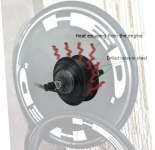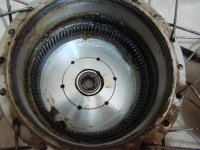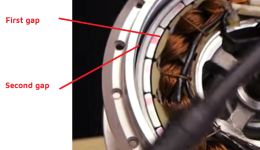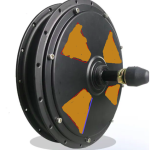Geared hubmotors don't have magnets between the flanges, but they do have the large ring gear (though this is usually confined to the side where the planetary gearing and clutch is located, so is parallel to just one flange).
Now, there *are* magnets on the rotor bell (for outrunners) on the motor itself, but that is not in contact with the shell where kk64 wants to drill the holes. (if it were, the gearing of the geared motor could not work as the rotor would be locked to the shell, and it would then be direct drive motor

).
To kk64: To find out if it will work, you need to build it and test it, first without any modifications, and then with your suggested modifications, with temperature monitoring instrumentation inside the motor's stator and if possible mounting temperature monitoring instrumentation on a "boom" from the axle up to as close as you can get to the outside of the rotor bell, to monitor the temperature of that as well, and another sensor on the boom to monitor the air temperature inside the shell.
Then you can compare the before and after to see what effect it really has.
Testing is what this thread is all about.

Myself, just as a first-look thought: I don't think it is going to help, and may actually make motor heating worse, because with the wheel cover addition, you'll be adding yet another layer (there are already two) of airgap and thermal transfer between the outside air passing by the wheell and the motor itself inside the hub shell and rotor bell. While the air venting of the hub shell between the flanges may allow some airflow out of the hub shell into the wheel cover area, it's still going to take the same amount of time to get the heat from the motor thru the air gap to the rotor bell *** and clutch / planetary gearset, then out of those into the air gap to the hub shell.
*** There is a solution to assist this part of the heat transfer, and that is to use statorade (discussed elsewhere in this thread) between the motor stator and the rotor bell magnets. Since this is not an encloseable area like a DD motor is, I don't know how long the statorade will stay in place, so it might have to be topped off more often than in a DD motor. But it has the potential to help with this specific part of the heat transfer.
Regarding the effects of water from the environment on the motor:
If you have the holes in the outside of the hub shell, and no wheel covers, any water that gets in can immediately drain out. While it's getting in there it will significantly help cool the motor, if that matters. As long as water does not stay in a motor, and isn't drowning the motor, it may not cause you any problems.
If you have salted roads in the winter, or other conditions that could get corrosive materials into the motor, then open holes it it are probably a bad idea.

Similarly, if you have roads with magnetically-attracted debris that coudl get flung up into the holes, that's also potentially a problem, as it may get into the rotor bell and stick to the magnets causing grinding between rotor and magnets.
Other debris (grit, dust, etc) that can get into the holes and get stuck on the gear grease could cause wear problems with the gearing.
If you don't have any of those on your riding paths / roads, you could just leave the holes open, with no wheel covers, and that probably would help a little bit with cooling the motor.
I have used a couple of DD hubmotors with side covers drilled open (one of them with bigger-than-quarter-sized holes), and neither one has had a problem with water, dirt, debris, or grit despite the road conditions here--there has been dust in them, but no debris and no water corrosion. But I have not tested this on a geared hubmotor, where the duts would probably stick to the grease and cause extra wear.
Myself, if I were to need to cool a geared hubmotor, I would use one of the partially-fluid-filled methods, probably one of the oils, if one is available that is compatible with the plastic of the gearing. I started to try ATF in a small Fusin geared hubmotor, but the sealing method I tried wasn't compatible with the ATF and it rapidly leaked out, so I never really got to test it; other stuff came up so I never did get back to solving that and trying it out. Since then I've used DD hubmotors, though I'm probably about to try a GMAC (unmodified).




![dsc06867[1].jpg dsc06867[1].jpg](https://endless-sphere.com/sphere/data/attachments/189/189274-4b83094f669e5db4f4df3a885608d462.jpg)


